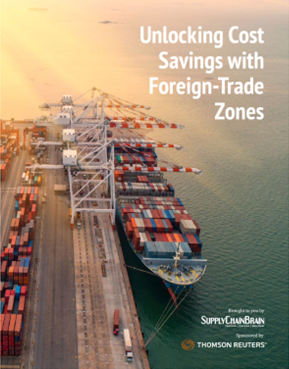U.S. manufacturers face an increasingly hostile, complex, and volatile trade environment today. Geopolitical tensions loom large in many parts of the world, impacting supply chains and triggering the threat of protectionist trade tariffs under the new U.S. Presidency, Donald Trump. New regulations are emerging and evolving, and compliance obligations are strict – creating the potential for huge fines, penalties and other costs for getting it wrong. Moreover, new Section 301 tariffs are constantly being added on products such as steel, aluminium, EV, lithium-ion batteries, and many other commodities, meaning that companies must be proactive to stay ahead in this fast-changing landscape.
Against this backdrop, using a Foreign-Trade Zone (FTZ) could be a smart move to mitigate risk, while unlocking significant cost savings.
Foreign-Trade Zones: What’s the idea?
FTZs give domestic manufacturers a level playing field with offshore rivals, by alleviating the tariff burden that would otherwise make it more cost-effective to base operations overseas.
Think of FTZs as duty-free shopping areas. Although FTZs are located on U.S. soil, the goods and materials within them have effectively not yet “gone through customs”, and so have not entered into the Commerce of the United States. Duties are only paid at the point when goods or materials leave the FTZ and enter the U.S. market. And if the goods are exported from the FTZ there is an opportunity to eliminate duty payment altogether.
They offer multiple ways to reduce import duties, including deferral, elimination, and reduction through tariff shifts. Companies can also save on local state taxes and generate cost savings by streamlining supply chain operations.
FTZs are not just for large corporations or those near ports or airports. Small and medium-sized companies are seeing the benefits, and FTZs can be located anywhere in the U.S. Businesses can designate their own or third parties’ existing facilities as FTZs – there is no need to build new plants or warehouses.
How do FTZs help save money and mitigate risk?
FTZs enable companies to save money, increase competitiveness and mitigate risk by:
- Insulating them against trade policy volatility – FTZs allow businesses to make strategic choices that lower costs and provide certainty overpayments. For example, they can choose to lock in tariff rates at the point where goods enter the FTZ, or at the time they leave it, enabling them to pay whichever rate is lower.
- Allowing them to manage deployment – When using FTZs, companies can defer duty payments indefinitely until the goods enter the U.S. market, helping smooth out cash flow. If they are exported to another country, there is no U.S. duty to pay. Manufacturers can also take advantage of “inverted tariffs”, whereby they can elect to pay duty on the raw materials or component parts instead of on the finished product if doing so results in a lower tariff.
- Facilitating compliance – Using FTZs for duty-free storage and export also reduces the risk of incurring penalties for non-compliance with complex trade regulations because they give trade compliance professionals space and flexibility to manage risk and make informed sourcing decisions.
- Enabling inventory optimization – There’s no time limit on whether to send goods to the U.S. market for sale or to export them to another country. So, businesses can keep safety stock for times of high demand, without paying duty on it, while they wait for the optimum time to release it onto the market. It’s also possible to mitigate the duty on scrap or unusable materials by reporting these in a particular way under FTZ rules.
- Streamlining customs operations and supply chains – Goods can get where they need to go quicker because many FTZ operators enjoy direct delivery privileges and simpler filings to secure release from the port of unlading. Plus, FTZs can open doors to other non-U.S. markets, namely in Canada and Latin America. They can help mitigate risks associated with international trade, such as fluctuations in currency exchange rates, trade disputes, or supply chain disruptions.
Creating strategic advantage in a high-stakes environment
The stakes are high: millions of dollars could be on the line. The importance of making the right decisions to protect the bottom line and prevent risk from being introduced into the business means trade compliance professionals are gaining influence within companies. As this happens, they are increasingly being seen as a strategic partner, rather than as a cost center.
Companies operating in an FTZ have to adhere to strict procedures and requirements, and compliance is key. Detailed records must be kept around each product, and the reports companies make to Customs must include details of their inventory control and recordkeeping systems (ICRS). Sophisticated FTZ software specifically designed for this purpose is invaluable, to ensure that compliance is robust and that the process of meeting those obligations is as straightforward as possible, such as by using software that enables self-filing.
Delivering flexibility and stability in an uncertain world
An FTZ isn’t the right route for every business, but companies shouldn’t ignore the potential advantages or be put off by the perceived complexity of setting them up. A thorough cost-benefit analysis can help determine whether it’s worth doing and how big the benefits could be. If just one area can be identified where tax can be deferred, minimized or eliminated, the substantial dollar savings could be a powerful inducement.
In an uncertain and volatile environment, the flexibility and stability that FTZs provide should not be underestimated. With trade tensions under intense strain, they can help businesses minimize risk and compete more effectively in a global market.
To learn more about how an FTZ could be a powerful tool for your businesses to save money, improve competitiveness, and navigate the complexities of international trade download a copy of our Special report.
 |
|